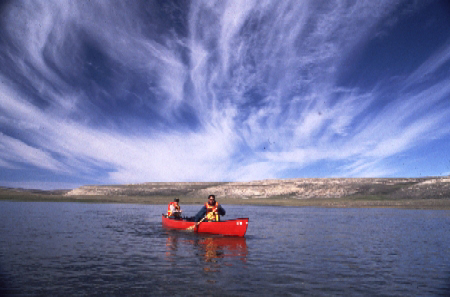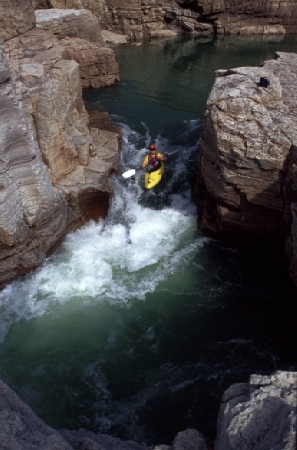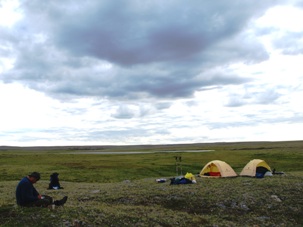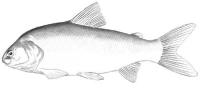Paddling

© Parks Canada / Christian Bucher
The Hornaday River, with its awe-inspiring canyons and waterfalls, is one of the main features of Tuktut Nogait.

© Parks Canada / Gilbert Wall
The river flows through Tuktut Nogait National Park before joining the Arctic Ocean, 14 kilometres east of the small community of Paulatuk.
There are two ways to access the upper Hornaday River. One is to start at Hornaday Lake and access the Hornaday River via its main tributary, the Little Hornaday River (185 km trip). The second approach is to start directly on the main river (145 km trip). Plan on 8-12 days to complete either route. The best time to paddle the river is July.
A journey down the upper portion of the Hornaday River offers park visitors a high quality wilderness experience as well as a challenging adventure. The upper Hornaday River is suitable for novice paddlers with advanced wilderness camping skills. The Little Hornaday River is suitable for experienced paddlers who are confident negotiating Class III rapids. Most paddlers end their trip at Uyarsivik (Cache) Lake. Between Uyarsivik Lake and the Arctic Ocean the Hornaday River enters three separate sections of largely un-navigable canyons stretching 40 km. In the final canyon section, the river spills over the magnificent, 21 m high La Roncière Falls. For a detailed description of paddling on the Hornaday River, please request a copy of the Hornaday River Guide from the Parks Canada office in Inuvik.
Hiking
With its open, easy terrain and spectacular scenery, Tuktut Nogait is a hiker’s paradise. The optimal hiking season extends from mid-June until mid-August. A particularly beautiful time to visit is the end of June, when the caribou are migrating and the wildflowers are blooming. Hikes can be extended into the third week of August when the autumn colours are at their peak. However, hikers traveling that late in the season could encounter winter-like conditions and delays due to heavy fog.
There are no designated trails in Tuktut Nogait. Hikers follow approximate routes, navigating by unmistakable landmarks such as creeks, rivers, valleys, lakes, eskers, and hills. Hiking route descriptions for the park are available from the Parks Canada office in Inuvik.
Camping

There are no designated campsites in the park. You may camp on any durable surface (e.g. gravel, rock or sand), except at archaeological sites. Look for rock arrangements such as tent rings and food caches before setting up camp. If you see any of these features leave the site undisturbed and set up camp in an alternate location.
Keep the landscape authentic; refrain from building markers or cairns (Inuksuit). If using rocks for stabilizing camp please disperse them when breaking camp.
Parks Canada has identified scenic and appropriate camping sites on the Hornaday River. Contact Parks Canada in Inuvik for a copy of the Hornaday River Guide. Whether hiking or paddling, there are an endless number of beautiful locations to choose from.
In order to protect this pristine wilderness, all visitors are expected to practice low impact backcountry etiquette. Campfires are prohibited in the Tuktut Nogait National Park.

Fishing
Tuktut Nogait is known for its good fishing. Arctic char and lake trout are the primary species caught. For those wishing to fish in the park, two types of Parks Canada fishing permits are available from the Inuvik Parks Canada office: an Annual permit or a day permit. The annual fishing permit is valid for one year in the park for which it is sold.
All fishers in the national park must possess a valid Parks Canada Fishing Permit. Government of the Northwest Territories Fishing Licences are not valid in Tuktut Nogait National Park. Annual and daily Parks Canada Fishing Permits are available from the Parks Canada Inuvik office.
Anyone under the age of 16 may fish in national parks without a permit if accompanied by a permit holder 16 years of age or older. However, their catch is then included within the permit holder's daily limit. They may also purchase their own permit and be entitled to the full catch limit.
Fishing Regulations
The daily catch and possession limit is 1 of any species (Arctic char, grayling, whitefish or lake trout). When angling, it is unlawful to:
- Fish without a Parks Canada Fishing Permit;
- Fish with a barbed hook, fishers may use barbless single hooks only;
- Fish with or possess within 100 metres of park waters the following:
- natural bait and chemical attractants;
- any lead tackle (sinkers, jigs, lures and flies) under 50 grams;
- lures with more than 2 gang hooks;
- A line capable of catching more than one fish at one time;
- Fish with more than one line at a time;
- Leave a fishing line unattended;
- Fish from 2 hours after sunset to one hour before sunrise;
- Allow your catch to spoil or to be wasted;
- Sell, trade or barter any fish caught;
- Place live fish or fish eggs in any park water or transfer them between bodies of water inside (or outside) the park;
- Place any food for fish in park waters;
- Fish closed waters. Closed to recreational fishing are:
- All waters downstream of La Roncieère Falls
- Seven Island Lake and its tributary to the Hornaday River, Akluk Creek
If you plan to fish on the privately-owned Inuvialuit lands outside the park, you must register with the Paulatuk Hunters and Trappers Committee and carry a Government of Northwest Territories Fishing Permit. National park fishing regulations do not apply to beneficiaries of the Inuvialuit Final Agreement.

Arctic char have the most northerly distribution of any freshwater fish. Although they seem to eat just about any small creature that is available to them, Arctic char grow slowly. They reach their full size at an average of 20 years, though some may live to 40.

In most waters, lake trout rely heavily on small fish like ciscoes, smelt, or sculpins. But in some lakes, they feed almost exclusively on plankton, insects, or crustaceans. Lake trout are slow-growing and long-lived, sometimes reaching an age of 60 years. In the far north, it may take 15 years for a lake trout to reach 2 pounds.

Arctic grayling are one of the most beautiful fish in the arctic. Males use the distinctive dorsal fin as part of a threat display when spawning.

Their diet consists mainly of small clams, snails, aquatic insects, larvae, and freshwater shrimp. In both species, the head is small and the body deep or wide from stomach to backbone.
Definitions
- Natural bait ban : you can only use lures made of feathers, fibre, rubber, wood, metal or plastic. No edible material, scented lures or chemical attractants are permitted.
- Barbless Hook : a hook with its barbs either removed completely or pressed against the hook shaft so they are not functional.
- Fly fishing only : means only artificial flies may be used. Artificial fly : this is a single or double hook on a common shank, dressed with silk, tinsel, wood, fur, feathers or other materials (no lead), or any combination thereof without a spinning device, whether attached to the hook or line.
- Tributary : any water course which flows into another body of water. This includes a tributary to a tributary. Lakes are excluded unless otherwise specified.
- Trout : for the purposes of this summary, the word trout includes char species.
Visitor Information - Fees
If you plan to fish on the privately-owned Inuvialuit lands adjacent to the park, you must register with the Paulatuk Hunters and Trappers Committee. Tel: (867) 580-3004.
Tuktut Nogait is rarely visited in the winter. The most suitable time for ski touring or snowshoeing in the park is from late March until early May, when the days are longer and the temperatures are generally warmer than in the early winter. Weather can still be extremely variable with temperatures ranging from above zero with mild, warm and melting conditions to falling well below -30° C with blowing snow and extreme wind. Please contact the Parks Canada office for more information on winter travel in the park.
Related links
- Date modified :